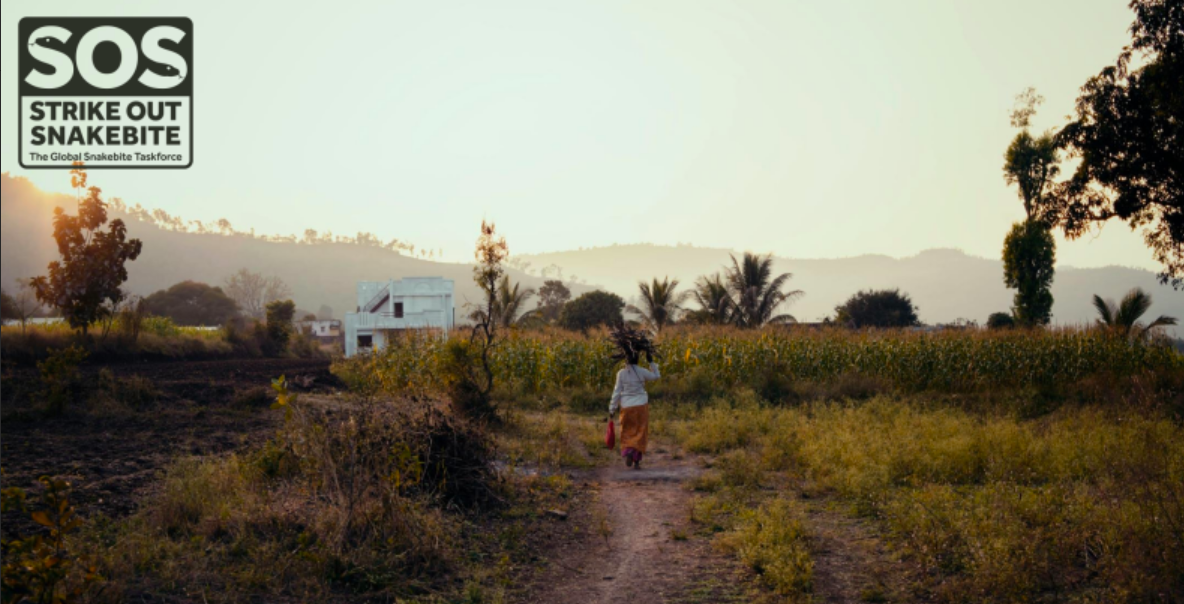
Press Release: 'VENOMOUS SNAKES' AT WORLD HEALTH ASSEMBLY; Striking Geneva 'Snakeover' signals urgent SOS for snakebite action

Geneva, Monday 19th May
– As world leaders gather for the 78th World
Health Assembly (WHA) in Geneva, the new Strike Out Snakebite (SOS)
initiative has unveiled a confronting art installation to highlight the
critical need for action against the daily threat of snakebite
envenoming that disproportionately and severely affects
some of the world’s most vulnerable communities.
nakebite is one of the world's deadliest yet most overlooked Neglected Tropical Diseases (NTDs), with one person dying every five minutes and many more suffering severe injuries and amputations that profoundly impact their lives and livelihoods. However, with increased visibility, political momentum and a clear investment pipeline this preventable global health issue can be tackled to eliminate needless suffering.
The public art series in Geneva's Parc Mon Repos aims to bring the urgency of the snakebite crisis to the international community’s attention.
Through 10 individual artworks, including a 3-meter snake sculpture and series of warning signs and illustrations, the series brings to life the physical threat, the significant human impact, and the hope inspired by scientific research and development.
The Strike Out Snakebite (SOS) initiative, aimed at ending preventable deaths and disabilities from snakebite, has also established a Global Snakebite Taskforce comprised of experts, policymakers, funders, researchers, health professionals, community advocates, and global leaders.
Co-chaired by the Hon Aden Duale, Cabinet Secretary to the Kenyan Ministry of Health, and Elhadj As Sy, Wellcome Board Member and Chancellor of Liverpool School of Tropical Medicine, the Taskforce’s mission is to elevate the visibility of this pressing issue on the global stage and catalyse resources for treatment and interventions that will prevent snakebite-related deaths and disabilities.
The
Taskforce has released a new report for the global community, including
policymakers, global leaders, public health authorities, communities,
and funders, tracking progress towards the
World Health Organization’s (WHO) target of halving deaths and
disabilities from snakebite envenoming by 2030.
The report highlights that significant advancements can be made if the global community invests in safe and effective treatments, ensures antivenoms are accessible to all, phases out substandard and false antivenom products from the market, equips healthcare systems and professionals with the necessary tools and knowledge, and supports community prevention and education initiatives.
With snakebite envenoming on the WHA agenda for the first time since 2020, the Taskforce is bringing it back in 2025 and have committed outlining the pathway to achieving these advancements over the next year.
Elhadj As Sy, Chancellor of the Liverpool School of Tropical Medicine and Co-Chair of the Global Snakebite Taskforce, said: "While the risk of snakebite may feel remote for many global leaders, the devastating and preventable human toll of snakebite envenoming can no longer be ignored by the international community. Our message is clear, nobody should be dying from a snakebite in 2025.
"This is a solvable challenge and one of the most cost-effective global health issues to tackle, with a real possibility to eliminate this suffering. We have many of the tools to save lives and livelihoods, but we urgently require the political will, momentum and funding. Together we can – and must – Strike Out Snakebite.”
With climate change increasing the likelihood of human-snake encounters, the 'Snakeover' installation sends an SOS to the international community. Artworks in the ‘Snakeover’ series include:
- Five larger-than-life snakes crafted out of recycled footwear, representing the inadequate footwear making people more vulnerable, in the national colours of some of the most burdened countries – including India, Pakistan, Nigeria and the Democratic Republic of Congo. Created by creative studio Lazerian, with soles etched with facts to expose the toll and threat of snakebite.
- An intricate paper sculpture of a Russell’s Viper, one of the world’s deadliest snakes, by artist Lisa Lloyd. Surrounding the snake are representations of antivenoms - reflecting the scientific and logistical complexity of developing effective treatment.
- ‘Danger! Venomous Snakes’ signage by artist Mr Finbar, referencing the real-life warning signs that people in high-risk communities in Africa, Latin America and Asia encounter every day.
- Posters across the city by Indian illustrator Rohan Dahotre, depicting a deadly Black Mamba and the vulnerability of snakebite victims in rural areas, alongside shocking facts depicting the scale of the issue.
Abhijeet Jayavant, a wildlife rescuer from Mumbai who was bitten by a venomous viper in 2009, has welcomed the increased attention on the issue. He contrasts his experience with those who lack access to treatment, saying:
"After I was bitten by a Bamboo viper, my arm swelled to double its size over night, but within two hours of the bite, I’d accessed antivenom. The treatment cost me the equivalent of about $130. But I’m very aware that there is no way some villagers could afford that. It’s more than some make in a month. For them, a bite is often a death sentence. Now I work on call to rescue snakes from locations across Mumbai. It’s very common for me to see Russell’s Vipers or Spectacled Cobras in people’s homes, just a few feet away from where they are sleeping. But groups like mine can only do so much. It’s going to take bigger, more coordinated action to save more lives and coexist with the urban wildlife of Mumbai.”
Nick Cammack, Interim Chief Research Programmes Officer at Wellcome, said:
"Snakebite
is a complex global health challenge that requires a co-ordinated
response and the launch of the Global Snakebite Taskforce at the WHA
marks a pivotal moment. Urgent
action is required to ensure communities most affected by snakebite can
access safe, effective treatments. There are promising solutions in the
pipeline, however we are still years from their adoption where they are
needed most. We need increased, sustained
investment in R&D to develop new, accessible antivenoms, in turn
improving lives around the world.”
The launch has been supported by charities and NGOs on the frontline, including Médecins Sans Frontières (MSF). Julien Potet, Senior Advisor, Tropical Diseases and Neglected Diseases from MSF, said:
"Snakebite is a crisis born from inequality, where access to treatment is too often a privilege, not a right. In simple terms, your survival depends on who you are and where you live. This stark reality – witnessed daily by our teams on the frontline of treating patients - underscores the critical need for global action to ensure equitable access to life-saving antivenoms.”
Artist Liam Hopkins, Lazerian Studios, said:
"The aim of our work is to make what has been invisible, visible. Many people in communities vulnerable to snakebite often walk barefoot or in flip flops, but very often, each step taken in non-protective footwear carries the threat of a venomous bite that can steal a life in moments. We’ve used recycled flipflops in each of our sculptures to humanise the vast toll snakebites have on people, families, and communities – whose deaths could be prevented with action and investment.”
To
learn more about Strike Out Snakebite and the work of the Global
Snakebite Taskforce in driving action for snakebite envenoming, please
visit www.linkedin.com/
The Strike Out Snakebite initiative and the Global Snakebite Taskforce has been made possible with the support of Wellcome.
ENDS
Leave a comment
- Popular
- Rated
- Commented
04/11/2021 - 11:05:02
28/05/2024 - 15:44:10
01/03/2021 - 09:00:37
Opinions
18/05/2025 - 16:26:37
15/05/2025 - 20:16:04
Politics
05/06/2025 - 13:42:50
Terror Watch
07/06/2025 - 21:36:45
Press Releases
05/06/2025 - 12:21:21
 0
0 




































Press Release: 'VENOMOUS SNAKES' AT WORLD HEALTH ASSEMBLY; Striking Geneva 'Snakeover' signals urgent SOS for snakebite action
- Venomous snake art installations have been unveiled in central Geneva to coincide with the World Health Assembly, as an urgent warning to the international community that snakebite envenoming can no longer be ignored. - For people in some of the